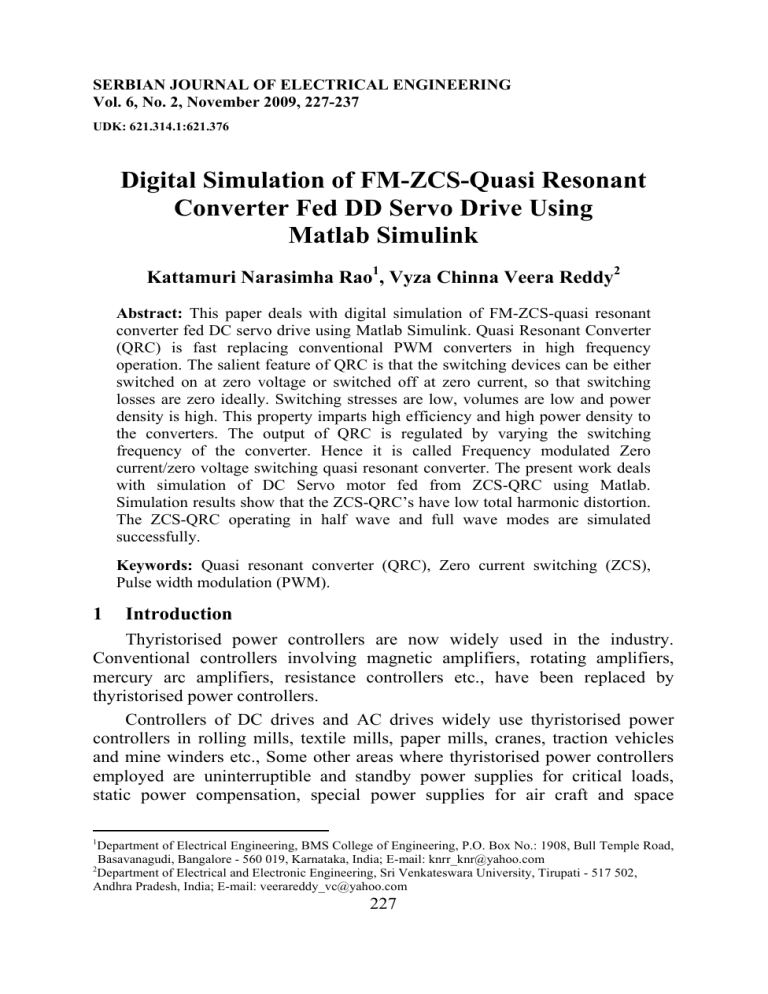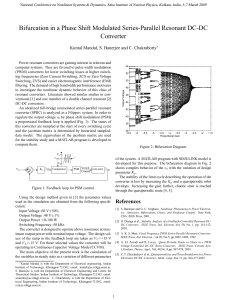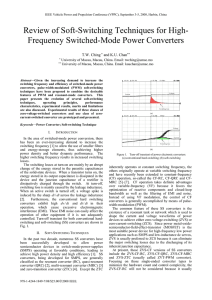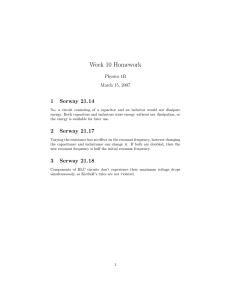Digital Simulation of FM-ZCS-Quasi Resonant Converter

SERBIAN JOURNAL OF ELECTRICAL ENGINEERING
Vol. 6, No. 2, November 2009, 227-237
UDK: 621.314.1:621.376
Digital Simulation of FM-ZCS-Quasi Resonant
Converter Fed DD Servo Drive Using
Matlab Simulink
Kattamuri Narasimha Rao
1
, Vyza Chinna Veera Reddy
2
Abstract: This paper deals with digital simulation of FM-ZCS-quasi resonant converter fed DC servo drive using Matlab Simulink. Quasi Resonant Converter
(QRC) is fast replacing conventional PWM converters in high frequency operation. The salient feature of QRC is that the switching devices can be either switched on at zero voltage or switched off at zero current, so that switching losses are zero ideally. Switching stresses are low, volumes are low and power density is high. This property imparts high efficiency and high power density to the converters. The output of QRC is regulated by varying the switching frequency of the converter. Hence it is called Frequency modulated Zero current/zero voltage switching quasi resonant converter. The present work deals with simulation of DC Servo motor fed from ZCS-QRC using Matlab.
Simulation results show that the ZCS-QRC’s have low total harmonic distortion.
The ZCS-QRC operating in half wave and full wave modes are simulated successfully.
Keywords: Quasi resonant converter (QRC), Zero current switching (ZCS),
Pulse width modulation (PWM).
1 Introduction
Thyristorised power controllers are now widely used in the industry.
Conventional controllers involving magnetic amplifiers, rotating amplifiers, mercury arc amplifiers, resistance controllers etc., have been replaced by thyristorised power controllers.
Controllers of DC drives and AC drives widely use thyristorised power controllers in rolling mills, textile mills, paper mills, cranes, traction vehicles and mine winders etc., Some other areas where thyristorised power controllers employed are uninterruptible and standby power supplies for critical loads, static power compensation, special power supplies for air craft and space
1 Department of Electrical Engineering, BMS College of Engineering, P.O. Box No.: 1908, Bull Temple Road,
2
Basavanagudi, Bangalore - 560 019, Karnataka, India; E-mail: knrr_knr@yahoo.com
Department of Electrical and Electronic Engineering, Sri Venkateswara University, Tirupati - 517 502,
Andhra Pradesh, India; E-mail: veerareddy_vc@yahoo.com
227
K.N. Rao, V.C.V. Reddy applications, transformer tap changers and static connector for industrial power systems, power conversion at the terminals of HVDC transmission system, HV supplies for electronic precipitators and X-ray generators.
2 Quasi Resonant Converter
The fundamental departure from the conventional “forced turn off“ approach is the “zero current switching” (ZCS) technique, proposed by F C Y
Lee et al (1987). Replacing the switches as power switches (MOSFET, GTO ) in the PWM converters by resonant switches gives rise to a new family of converters, namely “Quasi Resonant Converters“ (QRC). This new family of converters can be viewed as a hybrid between PWM converters and resonant converters. They utilize the principle of inductive or capacitive energy storage and power transfer in a similar fashion as PWM converters. The circuit topologies also resemble those of PWM converters. However an LC tank circuit is always present near the power switch and is used not only to shape the current waveforms through the power switch and the voltage waveform across the device. It can also store and transfer energy from input to output in a manner similar to the conventional resonant converters.
The two types of ZCS-QRC converters are: (a) half wave; (b) full wave as shown in Figs. 1(a) and 1(b).
(a)
(b)
Fig. 1 – (a) Half wave ZCS-QRC; (b) Full wave ZCS-QRC.
The following are the properties of zero current switching:
228
Digital Simulation of FM-ZCS-Quasi Resonant Converter Fed DD Servo Drive...
1.
The switch turn-on and turn-off occurs at zero current, which significantly reduces the switching losses.
2.
Sudden current changes in the switch are avoided in ZCS.
3.
The d / d t value is small, the stresses are reduced and hence EMI is reduced.
4.
The peak current [ I
0
+ V dc
/ Z
0
] Conducted by switch must be more than twice as high as the maximum of the load current characteristic impedance
I
0
and Z
0
is the
5.
The output voltage can be varied by varying the switching frequency.
6.
The internal capacitances of the switch are discharged during turn on in
ZCS, which can produce significant switching loss at high switching frequency.
(a)
(b)
Fig. 2 – (a) Power circuit of Half wave FM-ZCS-QRC fed servo drive ;
(b) Waveforms of Half wave FM-ZCS-QRC.
229
K.N. Rao, V.C.V. Reddy
A conventional Frequency modulated-zero current switching-Quasi resonant converter circuit and its operating waveforms are shown in Figs. 2(a) and
2(b) respectively. The sinusoidal current waveform in the case of zero current resonant switch/the sinusoidal voltage waveform in the case of Zero voltage resonant switch, generated by the waveform shaping LC resonant elements creates a zero current/voltage condition for the switch to turn-off/turn-on without switching stresses and losses, which are given by various mathematical equations from (1) to (9).
(
A switching cycle can be divided into four stages. The associated equivalent circuits for these four stages are shown in modes of operation for half wave and full wave circuits respectively. Assume initially free wheel diode
D fw
) carries the output current ( I
0
) and resonant capacitor voltage ( V
Cr
) is clamped at zero and switch S is off. At the beginning of the switching cycle t t
0
, S is switched on.
3 Modes of Operation
1. MODE 1 : When S is turned on at =
0
, the input current ( and is governed by the state equation V = L r
(d i
Lr t i
Lr
) rises linearly
. The duration of the mode, t d 1
= ( t
1
− t
0
) can be solved with boundary conditions which can be expressed by equations (1) i t
0
⇒
= i t
1
= I
0 t d 1 t
1 t L I
0
/ .
(1)
Fig. 3 – Equivalent circuit for mode 1.
2. Mode 2 : At time =
1
, when the input current rises to the level of I
0
, D fw
is turned off and the amount of current (
Lr
( ) can be given by the state equations (2) to (5):
− I
0
) is now charging C r
, which
230
Digital Simulation of FM-ZCS-Quasi Resonant Converter Fed DD Servo Drive...
C
L r
Lr r d V
Cr d t d i
Lr d t
= i
Lr
= −
− I
Cr
0
,
( ) = I
0
+
V
Z
0 sin ω t ,
, (2) with the initial conditions V t
1
= and i t
1
= I
0
.
If a half wave resonant switch is used, switch S will be naturally commutated at time when the resonating input current i t reduces to zero.
On the other hand, if a full wave resonant switch is used, current i t will continue to oscillate and energy is fed back to source, V through D fw
. Current through D fw
again oscillate to zero. The duration of this stage be solved by setting i t
2
= . t d 2
= ( t
2
− t
1
) can
Fig. 4 – Equivalent circuit for Mode 2 operation .
Thus, t d 2
=
α
ω
, (3) where
α = arcsin , (4)
V
3 / 2 for half wave mode;
3 / 2 2 for full wave mode.
At time t
2
, V
Cr
can be solved using:
( d 2
) = V − α . (5)
231
K.N. Rao, V.C.V. Reddy
3. Mode 3 zero. At
: This stage begins at t
2
, when the current through inductor
=
2
, S is turned off. The Capacitor C r
L r
is
discharges through the load to supply constant load current. Hence V
Cr
decreases linearly and reduces to zero at t
3
. The state equation for this mode is given by the equations (6) to (8)
C r d V
Cr d t
= I
0
. (6)
The duration of this stage t d 3
= ( t
3
− t
2
) (7) can be solved with the initial condition.
V t = V − α . (8)
Fig. 5 – Equivalent circuit for Mode 3 operation .
4. Mode 4 : This stage starts with the conduction of freewheeling diode and the armature current freewheels through D fw
for a period t d 4
until S is turned on again. The duration of this stage is t d 4
= T
S
− t d 1
− t d 2
− t d 3
, (9) where T
S
is the period of a switching cycle.
Fig. 6 – Equivalent circuit for Mode 4 operation .
232
Digital Simulation of FM-ZCS-Quasi Resonant Converter Fed DD Servo Drive...
(a)
(b)
(c)
Fig. 7 – (a) Half wave ZCS QRC with RLE Load ;
(b) Current through inductor L r
; (c) Voltage across capacitor C r
.
233
K.N. Rao, V.C.V. Reddy
The understanding of the operation of a power electronic circuit requires a clear knowledge of the transient behavior of current and voltage waveform for each and every circuit element at every instant of time.
For the easy understanding of the transient response computer aided simulation software’s were used. The FM-ZCS-QRC has been simulated using
MATLAB simulink software. For simulation purpose the values chosen are
L r
= 168 H C r
= μ , V = 75 V , 5 , 30 mH , and E b
= 35 V .
Half wave ZCS QRC with RLE load is shown in the Fig. 7a. The current through the inductor is shown in the Fig. 7b. Voltage across the capacitor is shown in the Fig. 7c. Full wave ZCS QRC with RLE load is shown in the
Fig. 8a. The current through the inductor and Voltage across the capacitor is shown in the Fig. 8b. Full wave ZCS QRC with motor load is shown in the
Fig. 6a. The current through the inductor is shown in the Fig. 9b. Voltage across the capacitor is shown in the Fig. 9c. Speed response curve is shown in Fig. 9d.
The speed increases and settles at 100 rad/s.
(a)
(b)
Fig. 8 – (a) Full wave QRC with RLE load ;
(b) Current through inductor L r
and voltage across capacitor C r
.
234
Digital Simulation of FM-ZCS-Quasi Resonant Converter Fed DD Servo Drive...
(a)
(b)
(c)
235
K.N. Rao, V.C.V. Reddy
(d)
Fig. 9 – (a) Full wave QRC with motor load .; (b) Current through inductor L r
;
(c) Voltage across capacitor C r
; (d) rotor speed in rad/sec.
5 Conclusion
The FM-ZCS-QRC was simulated using MATLAB SIMULINK software.
By virtue of this modeling approach, design of quasi resonant converters can be realized efficiently and effectively by using soft switching techniques.
Switching stresses get reduced since voltage and current waveforms have lesser slope. Power density is increased since the volume is reduced. The approach of maintaining zero current switching condition is also identified from the simulated waveforms, ie. whenever current is zero, switch S turns on and off.
Simulation waveforms coincide with theoretical waveforms. QRC fed Servo drive is a viable alternative to the DC drive since it has less losses and high power density. The speed of the servo motor can be varied by varying the off time of the QRC.
6 References
[1] S.R. Reddy, C. Chellamuthu: Performance of a DC Motor Fed from Series and Parallel
Quasi-resonant Converters, International Journal of Power and Energy Systems, Vol. 17,
No. 3, 1997, pp. 161 – 168.
[2] L. Bo-Tao, L. Yim-Shu: Novel Actively-clamped Zero Current Switching Quasi-resonant
Converters, IEEE International Symposium on Circuits and Systems, Hong Kong, 9-12 June
1997, Vol. 2, pp. 869 – 872.
[3] L.K. Wong, F.H. Leung, P.K.S. Tam: A Simple Large Signal non Linear Modeling
Approach for Fast Simulation of Zero Current Switching Quasi-resonant Converters, IEEE
Transactions on Power Electronics, Vol. 12, No. 3, May 1997, pp. 437 – 442.
236
Digital Simulation of FM-ZCS-Quasi Resonant Converter Fed DD Servo Drive...
[4] G.H. Cho, J.G. Cho: Cyclic Quasi-resonant Converter: a New Group of Resonant
Converters Suitable for Higher Performance DC/DC and AC/AC Conversion Applications, proc IEEE IECON, 1990, pp. 956 – 963.
[5] B.T. Lin, G. Lin, S.S. Oiu: A New Group of Quasi-resonant Converters, South Ohina
University Proc, Vol. 23, No. 8, 1995, pp. 131 – 137.
[6] K.H. Liu, O. Ramesh, F.C.Y. Lee: Quasi-resonant Converters Topology and Characteristics,
IEEE Transactions on Power electronics, Vol. PE-2, No. 1, Jan. 1987, pp. 62 – 71.
[7] R.B. Ridely, W.A. Tabisz, F.C.Y. Lee, V. Vorperian: Multi Loop Control of Quasi-resonant
Converters, IEEE Transactions on Power Electronics, Vol. 6, No. 1, Jan. 1991, pp. 28 – 38.
[8] G. Ume, C. Chellamuthu: A Novel Closed Loop Operated Soft Switched DC to DC
Converter for Electrical Vehicles, IEEE Power Engineering Society Winter Meeting 2000,
Vol. 1, pp. 319 – 323.
[9] K.N. Rao, V.C.V. Reddy: Implementation of FM-ZCS-Quasi Resonant Converter fed DC servo drive, Journal of Theoretical and Applied Information Technology, Vol. 5, No. 4,
April 2009, pp. 432 – 436.
[10] K.N. Rao, V.C.V. Reddy: Digital Simulation of FM-ZCS-Quasi Resonant Converter Fed
DC Servo Drive using Matlab Simulink, IESPEEE09 , SRM University, Chennai, India.
[11] P.C. Sen: Prinicples of Electric Machines and Power Electronics, 2nd edition, Wiley
Publications, Dec. 1996.
[12] S. Arulselvi, C. Subhashini, G. Ume: A New Push-pull Zero Voltage Switching Quasiresonant Converter: Topology, Analysis and Experimentation, IEEE INDICON 2005, 11-12
Dec. 2005, pp. 482 – 486.
[13] S. Arulselvi, G, Uma, B. Kalaranjani: Design and Simulation of Model based Controllers for
Quasi Resonant Converters using Neural Networks, India International Conference on
Power Electronics 2006, IICPE 2006, Chennai, India, 19-21 Dec. 2006, pp. 197 – 202.
237




